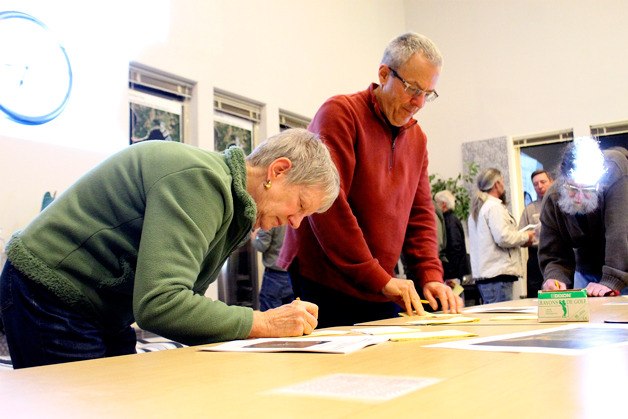While the thinning of affected trees at South Whidbey State Park in Freeland drew resistance from Whidbey residents at a public input meeting Thursday night, support for kite-boarders in Useless Bay was strong.
Another step toward finalizing the future of three state park properties on South Whidbey was made at the meeting.
Over 40 people attended Washington State Parks’ public meeting at Whidbey Water Services in Freeland for the second stage of its Classification and Management Plan, or CAMP, process.
Parks Planner Randy Kline gave a presentation on potential park management approaches for three properties: South Whidbey State Park, state park tidelands in Useless Bay, and Possession Point State Park. Participants were asked to provide feedback on proposed alternatives developed based on public input from the first public meeting held in October. Attendees wrote their thoughts and opinions on sticky notes and placed them on corresponding posters of each proposed alternative.
The goal of the meeting was to establish preliminary management alternatives that will include land classifications and potential park management approaches. Parks officials will compile the input and use it as a means of understanding the range of possibilities and feedback of the potential directions they could take.
In the spring of 2015, tree rot and disease led the state to close overnight usage at the Freeland park for safety concerns. The options for the state park include permanently closing the campgrounds for overnight use or thinning affected trees, while potential zoning of Possession Point State Park and 560 acres of tideland in the Useless Bay area could range from classifications of “natural” to “recreational.”
Attendees ranged from longtime residents who cherish the state park to kite surfers who frequent the Useless Bay waters. 
Freeland resident Susan Bennett said she and her husband are environmentalists and care about the state park “very much.” Bennett ultimately didn’t favor one direction or another for the park, but noted that she revered the park as it is.
“If the campground is to stay a campground, (the trees) have to come down sooner — I understand that, but trees are not timber when they’re still standing,” she said. “That park is a just a jewel on Whidbey Island.”
Clearing the affected trees from the area draws two issues of concern. The first is it is unclear how much thinning would be required to make the area safe for campers. There is also dread that too much clearing would lessen the draw of people coming to the park.
Ann Sullivan of Greenbank said she would like to see the park preserved for its “own restoration and longevity,” and added that creating an interpretive center at the state park could be a draw for school districts looking to conduct outdoor classrooms.
Langley resident Tim Legree echoed Sullivan’s opinion by saying the state park needs to take care of the trees. He said he would like to see camping, but thought the park needs to be nurtured as much as it is utilized.
There were several notes submitted that were in favor of increasing public accesses at the Useless Bay tidelands, which were purchased in 1947. The land is not contiguous and is split between areas north of Double Bluff and south of Deer Lagoon around Sunlight Beach. A natural classification would leave ecologically sensitive areas unmolested and ban activities such as kite-boarding.
Useless Bay resident Steve Boyle and Jesse Theford of Greenbank came to the meeting with five other kite boarders after reading a recent article in The Record.
“We’re just trying to see if they change or create a classification and that classification still allows people to walk out there and bring a kite and launch a kite so you can go ride,” Boyle said.
Useless Bay resident and Island County Diking District 1 Commissioner John Shepard said the kite-boarders are a source of entertainment for residents.
“They’re quiet, they’re non-polluting, they don’t cause any problems with any of us,” Shepard said. “I’d say we’re in favor of kite-boarders, but we’re not too happy with jet skis.”
Shepard said the natural classification would also prevent many homeowners who currently have boats along the tidelands from crabbing and fishing.
“This is sort of the culture of the beach down there,” Shepard said. “If you made it natural and banned having boats out there and our buoys out there, there would be a real revolt. This is something that would be extraordinarily objectionable to the community.”
Several attendees wrote they would be in favor of a recreational classification for the 25-acre Possession Point State Park. The park is currently a destination for the Cascade Marine Trail, a path through Puget Sound for kayakers and other non-motorized vessels. Others said designating the area as such would open up the potential for “far too many non-marine trail activities.”
Bennett held a similar stance.
“In my humble opinion, the uplands have to be maintained the way they are, otherwise we’ll have slides and we won’t have any lowlands,” she said.
With stage two completed in the CAMP process, the third phase is on the way. It will include preliminary recommendations using the best ideas from the alternative approaches developed in Thursday night’s meeting. A State Environmental Policy Act (SEPA) checklist will also be completed during this stage, which will describe environmental impacts of the recommendations. The Washington State Parks and Recreation Commission will vote on the CAMP plans at a public meeting Sept. 22 in Sequim.


